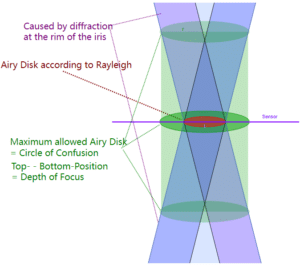Per Definition
DOF := Far Point – Near Point.
The formulas for these are really complicated and contain several times the focal length.Surprisingly, despite the formulas given there:
The focal length has no influence on the DOF if FOV and are constant.
in other words :
As long as FOV and F# are both constant, the DOF is the same from whatever distance.
Because the brighness shall stay the same, the F# is the same.
Because the FOV is the same, also the Magnification is the same for both lenses.
Because the F# is the same, also the NA (Numerical Aperture) is the same.
This is because .
As , also the angle
doesn’t change.
Our definition of sharpness, the allowed circle of confusion, of course shall not change.
Also, due to the Rayleigh Criterion, the resolution of the lenses is the same (assuming lenses of the same, diffraction limited excellent quality).
So if we have a close look at the location where the light gathers for one pixel, we see ..

Diffraction at pixel Level
The red disk shows the smallest Airy disk Possible, according to Rayleigh – controlled only by Wavelength and . (See Rayleigh Criterion). The diameter is (according to Rayleigh) twice the lens’ resolution.
The green disk is the user’s definition of “is still focussed”. As the angle is constant, so is
, which is the opening angle of the double cone at pixel level.
As angle and slimmest part of the double cone are the same, so is the upper and lower point where the Green disk touches. The distance of upper and lower max. point of the green disk is the image side Depth of Focus. The object side DOF (depth of field) is Depth of Focus / Magnification , which is constant, because the FOV is constant.

